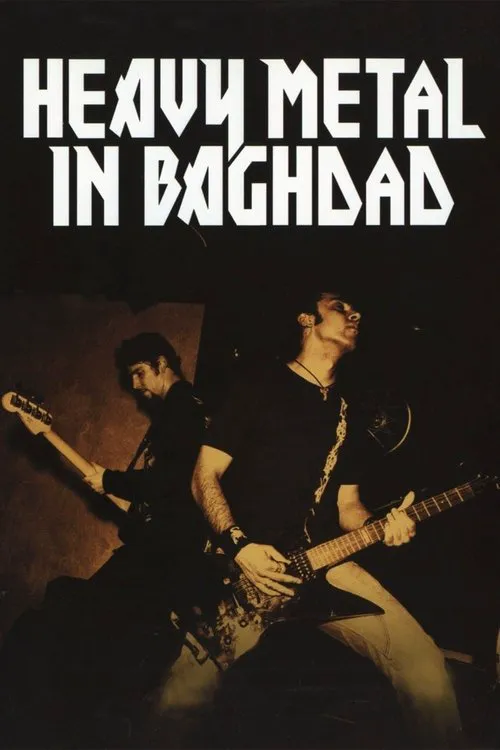Heavy Metal in Baghdad

Plot
In the early 2000s, the world was witnessing a pivotal moment in history - the Iraq War was raging, with its chaotic aftermath and occupation. Amidst the devastation, a remarkable story emerged, one that showcased the resilience and determination of the Iraqi people. Heavy Metal in Baghdad tells the story of Acrassicauda, Iraq's only heavy metal band, and their courageous fight to play music despite the overwhelming opposition. The documentary begins in Baghdad, where we meet the band's founding members, Firas Al-Lissy, Bilan Al-Lissy, Sattar Sabah, and Ali Khalaf. As children, they had discovered metal bands such as Black Sabbath, Iron Maiden, and Judas Priest, which became a source of inspiration and rebellion against the oppressive regime. When Saddam Hussein's regime fell, their dream of playing metal music in Iraq seemed within reach. However, reality quickly took a different turn. As the occupying forces struggled to establish a new government, the country descended into chaos. Bombings, explosions, and gunfire became commonplace, and sectarian violence tore communities apart. The Iraqi people felt trapped in a never-ending nightmare, and their desire to play music was seen as a luxury they could ill afford. Acrassicauda's struggle began with the band's first attempts to rehearse. Despite having found a potential venue, they were repeatedly forced to cancel their practices due to security concerns. Firas Al-Lissy, the band's charismatic guitarist, described the ordeal: 'We couldn't play music anywhere - there were always people fighting nearby.' The fear of being caught in the middle of a shootout made their dream of playing metal seem like an impossible task. Meanwhile, the band members' personal lives were becoming increasingly complicated. Firas was working multiple jobs, including driving for a foreign contractor, just to make ends meet. Bilan Al-Lissy, the bassist, and his family were forced to flee their home in a Baghdad neighborhood due to the constant bombardment. As the band members juggled their day jobs, family obligations, and their passion for metal music, it became apparent that playing music was no longer just about fun - it was about survival. The band's perseverance, however, eventually paid off. In 2003, Firas and Bilan received a grant from a US-based arts organization to record their first album. Acrassicauda hastily assembled a makeshift studio in Firas's living room, using a borrowed computer and makeshift recording equipment. After several failed attempts and a chaotic first recording session, they finally managed to capture the essence of their songs. As the band's music became more polished and their profile grew, they started to attract international attention. The New York Times, The Guardian, and other global media outlets featured them, and a music video of 'Angel of Death', a cover of a Slayer song, went viral on YouTube. The exposure not only brought them fame but also put their lives at risk. Firas and Bilan's families faced constant harassment from militias and extremist groups who condemned metal music as a Western influence. Firas's family received threatening phone calls and even a visit from a local leader, warning them to stop supporting the band. As the threats escalated, the band members were forced to flee Baghdad and settle in other cities, like Basra and Erbil. Their ultimate goal was to perform live and prove that their music could transcend cultural and national barriers. In 2006, Acrassicauda embarked on a grueling journey to attend the famous Download Festival in the UK, where they would make their international debut. The experience was nothing short of life-changing - the band members were awestruck by the sea of metalheads, the thunderous music, and the sheer energy of the crowd. Firas described the moment: 'We played the biggest metal show of our lives, and there were no bombs, no guns, no chaos. Just music. It was amazing.' The rest of the documentary chronicles the band's struggles to keep playing music amidst the war. Bilan Al-Lissy's family was forced to flee Iraq, relocating to the US for their safety. Firas and the rest of the band continued to play, albeit in secret, always looking over their shoulders. In 2007, Firas Al-Lissy's sister, Sura Al-Lissy, was kidnapped by a Sunni militia and brutally murdered. Firas and Bilan felt defeated and lost, wondering why their music couldn't bring peace to their war-torn country. And yet, Heavy Metal in Baghdad leaves us with a sense of hope and resilience. As Acrassicauda continued to play, inspiring young Iraqis to defy the odds, their music transcended borders and politics. It became a symbol of resistance, a rebellion against the forces that sought to silence them. Their legacy is a testament to the power of music to bring people together, to challenge the status quo, and to inspire change. In a poignant conclusion, the film captures Acrassicauda's final performance at the Iraqui National Museum, a venue once a symbol of Saddam Hussein's regime. The band, battered but unbroken, took the stage, their faces worn but their spirits unyielding. As the crowd erupted in cheers and applause, the heavy metal anthem 'The Number of the Beast' echoed through the halls, an anthem of defiance and survival in the face of unimaginable adversity.
Reviews
Recommendations




